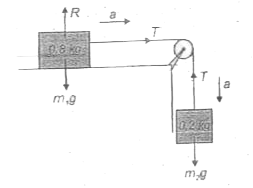A block of metal weighing 2kg is resting on a frictionless plane. It is struck by a jet releasing water at a rate of 1kg/s and at a speed of 5 m/s. Calculate the initial acceleration of the block.
The correct Answer is:[2.5m/s2]
To solve the problem, we will follow these steps:
Step 1: Understand the given data
- Mass of the block (m_block) = 2 kg
- Rate of mass flow of water (dm/dt) = 1 kg/s
- Speed of water jet (v_jet) = 5 m/s
Step 2: Calculate the force exerted by the water jet
The force exerted by the water jet can be calculated using the formula for momentum change per second (which is also the force). The change in momentum per second (force) is given by:
F=dmdt×vjet
Substituting the values:
F=1kg/s×5m/s=5N
Step 3: Calculate the acceleration of the block
Using Newton's second law, the acceleration (a) of the block can be calculated using the formula:
F=mblock×a
Rearranging this gives:
a=Fmblock
Substituting the values:
a=5N2kg=2.5m/s2
Final Answer
The initial acceleration of the block is 2.5m/s2.
---
- Mass of the block (m_block) = 2 kg
- Rate of mass flow of water (dm/dt) = 1 kg/s
- Speed of water jet (v_jet) = 5 m/s
The force exerted by the water jet can be calculated using the formula for momentum change per second (which is also the force). The change in momentum per second (force) is given by:
Using Newton's second law, the acceleration (a) of the block can be calculated using the formula:
The initial acceleration of the block is 2.5m/s2.
Topper's Solved these Questions
- NEWTONS LAWS OF MOTIONBOOK - PHYSICS GALAXY - ASHISH ARORACHAPTER - NEWTONS LAWS OF MOTIONEXERCISE - Advance MCQs
17 Videos
- LINEAR MOMENTUM & ITS CONSERVATIONBOOK - PHYSICS GALAXY - ASHISH ARORACHAPTER - LINEAR MOMENTUM & ITS CONSERVATIONEXERCISE - exercise 1.3
3 Videos
- RIGID BODIES AND ROTATIONAL MOTIONBOOK - PHYSICS GALAXY - ASHISH ARORACHAPTER - RIGID BODIES AND ROTATIONAL MOTIONEXERCISE - Unsolved Numerical
63 Videos
Similar Questions
A block of 5 kg is resting on a frictionless plane. It is struck by a jet releasing water at the rate of 3 kg/s at a speed of 4 ms−1. Calculate the initial acceleration of the block.
View SolutionA block of metal weighing 4kg is resting on a frictionless plane . It is struck by a jet of releasing water at the rate of 1kgs−1 and at a speed of 10ms−1 Calculate the intial acceleration of the blocks .
View Solution
Knowledge Check
A block of metal weighing 2kg is resting on a frictionless plane. It is struck by a jet releasing water at a rate of 1kgs−1 and at a speed of 5ms_1. The initial acceleration of the block is
 A53m/s2B254m/s2C258m/s2D52m/s2
A53m/s2B254m/s2C258m/s2D52m/s2A block of metal weighing 2kg is resting on a frictionless plane. It is struck by a jet releasing water at a rate of 1kg/s and at a speed of 5m/s. The initial acceleration of the block will be
A2.5m/s2B5m/s2C10m/s2D20m/s2A block of metal weighing 2kg is resting on a frictionless plane. It is struck by a jet releasing water at a rate of 1kgs−1 and at a speed of 5ms_1. The initial acceleration of the block is
 A53ms−2B254ms−2C266ms−2D52ms−2
A53ms−2B254ms−2C266ms−2D52ms−2
A wooden block of mass 0.8 kg is dragged along a level frictionless surface by a hanging block of mass 0.2 kg as shown in the figure. Calculate the tension in the string and the acceleration of blocks.

View SolutionA block of mass 2 kg is resting on a frictionless plane. It is struck by a jet releasing water at a rate of 1 kg/s with speed 5 m/s. The initial acceleration of the block will be :-
View SolutionA block of weight 4 kg is resting on a smooth horizontal plane. If it is struck by a jet of water at the rate of 2 kg s−1 and at the speed of 10 m s', then the initial acceleration of the block is
View SolutionA block of metal weighing 2kg is resting on a frictionless plane. It is struck by a jet releasing water at a rate of 1kg/s and at a speed of 5 m/s. Calculate the initial acceleration of the block.
View SolutionA block of weight 8 kg is resting on a smooth horizontal plane. If it is struck by a jet of water at the rate of 2kgs−1 and at the speed of 20 m s−1 , then the initial acceleration of the block is
View Solution
